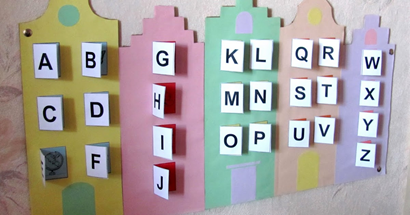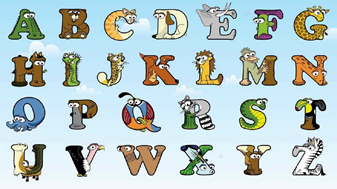- Tip #1. Correct English does not start with the alphabet.
- Tip #2. The names of the letters and their sequence are secondary.
- Tip #3. Vowels – last of all.
- Tip #4. Fairy tale comes to us!
- Tip #5. Play, play, play.
- Tip #6. Creativity is our everything.
- Tip #7. Learning in close cooperation.
The things parents do to teach their children the English alphabet! The most “non-working” techniques:
- print the English alphabet out and learn it
- print the English alphabet with transcription
Transcription is even more difficult than the alphabet itself, so to quickly learn the English alphabet, these techniques are replaced with similar ones:
- write the English alphabet with letters in your language
- print the English alphabet out with transcription in your language
Many people try somehow to diversify purely mechanical memorisation and then use the following methods:
- listen to the alphabet songs in English
- watch the alphabet videos and cartoons
- make cards with the English alphabet
- print out writing books with English letters for children
- use online tools to memorise English letters.
The way the alphabet is taught in most schools, where children aged 7-8 begin to learn English, is not even worth remembering. It is enough to mention that many schoolchildren at the age of 9 or 10 can read in English provided that English words are written in their native language’s letters!
In article (first long read), we tried to bust the existing myths about learning the English alphabet. Now we are going to tell you how to arrange the ABC to learn in such a way that it is fascinating and effective and forms (has) a solid base for further development of quality reading and writing skills.
Tip #1. Correct English does not start with the alphabet.
No, no, no! First of all, this is because language is live communication. It is oral by nature; we hear it, listen to it and use it to express our thoughts, desires and intentions. Oral communication is the most important function of any language. No matter what age you start learning a language – an oral, introductory course should be most important. It goes without saying when teaching English to children:
- Firstly, the oral course removes psychological barriers.
- Secondly, there is an immersion in the language environment, i.e. the brain gets a command to listen, hear and remember.
- Thirdly, students immediately begin to perceive English sounds; they learn the correct phonetic image of words, which will be very important later when getting acquainted with the written image.
Tip #2. The names of the letters and their sequence are secondary.
Yes, yes, yes! The English alphabet, which is learned and sung in all kinds of ways, is just for the sake of appearances; this is just an indicator of a good memory. The most important thing is to teach phonics.
“Phonics is a learning technique that helps children learn to match phonemes (sounds) and letters.”
The introduction and remembering of phonics sounds and their letter equivalents are based on the material learnt during the introductory course and the experience of live communication. It is important to establish strong associations between a sound, letter and a word, so the phonics you present should always be contextualised; for example, “ddd-dog”, “Dd” is not just a single letter but a sound that “dog” or “duck” start with.
First of all, you present a picture with a word, then you say the word, after that you highlight the needed sound, and then show the letter. You can say several words and ask students to find the same sound.
Introduction of phonics, if your students want it and are ready for it, can start at the age of 5, and children of 6-7 years old easily learn both phonics and letters. The number of sound-letter combinations presented at a time is individual, but 3-5 at a time is quite acceptable.
Tip #3. Vowels – last of all.
Vowels are the most insidious “inhabitants” of the English alphabet; there are only 6 of them, but 6 letters give… 20 sounds! Just compare, 20 consonants give only 24 sounds. Since the vowels are so insidious, then we will start making friends with them much later. At first, you can perfectly do without them! How is it possible?! It is very easy ? Remember that the ancient Phoenicians had no vowels in the alphabet, and they somehow managed to do without them! All the time! We will do the same only at the beginning ?
It is important to teach a child not only to see and correctly name the letter-sound combinations but also to analyse the sound composition by ear. This transition point is often omitted, and sometimes you start reading immediately after the letters are learnt. Children have excellent visual memory. They can easily remember the sounding and spelling but do not divide words into sounds and sentences into words, i.e. without an intermediate training stage, the ability to identify individual units of sound and spelling will not be formed.
Before learning to read, you need to learn to hear and relate what you hear to what you write. And here, the knowledge acquired during the speaking course goes to the rescue. You can learn to hear consonant sounds by using the names of colours (red, blue, green), numbers, animals (cat, dog, fox, etc.), and common action verbs (run, jump, swim, sing, dance, etc.). These words are easily and quickly learnt by children, and one cannot speak English without them. Tasks with pictures (“listen and point”) or matching and circling (“listen and match” or “listen and circle”) are the best for practising sound-letter combinations. And we do not need vowels at all!
Tip #4. Fairy tale comes to us!
How to start learning English letters and sounds with children? The English alphabet has 26 letters. It is less than in some other languages. Still, it’s a lot. At the beginning of learning, a child will perceive it as something new and will definitely be interested, so drawing attention to the process and keeping it will not cause any difficulties. But later, by the middle of the alphabet, the interest can significantly fade, and by the end, it will disappear at all. What should we do? Tell tales, of course! Which tales? About the alphabet and its inhabitants!
You can make a house and gradually “settle” the learned letters there.

You can create short stories with letters as main characters and act them out. Or create short stories where the names of all the characters start with certain letters, and something interesting happens to them.
The chosen strategy will determine whether to present the letters in order or group them depending on the situation (the story content). Whatever way you choose, the main thing is the emotional and visual impact on a child, the ability to show creativity, fine motor skills, speaking and play activity.
Tip #5. Play, play, play.
Regardless of the age at which the child begins to learn the alphabet, the process of memorisation should in no case be boring. Sit, watch and repeat – this is not about children! All types of activity should be included in the learning process – speaking, motor, creative and, of course, play. Do not forget to embrace all four types of memory – visual, auditory, motor and tactile. Children should be able to see the letters, touch them, draw them and hear and sing sounds. And in order to remember letters and sounds, you need to play with them!
The most popular games for learning the English alphabet are:
- Lotto (bingo)
- Dominoes
- What’s missing?
- Fishing
- Hide and seek
- Guess the letter
- Memory
- Path
- Hungry dragon
- Puzzles
- Mazes
- Snakes and Ladders
Game tasks for memorising the alphabet will not let your child get bored! Want to know more? Read about ____ (Alphabet: How to)
Tip #6. Creativity is our everything.
Games are games, but all children are great creators! And the learning process lacking the development of fine motor skills is not learning. And, of course, do not forget about providing opportunities to unlock creative potential. How? Through learning letters, of course! We use any materials at hand and include children’s favourite activities. It is so much fun to:
- Make the letters of matches or grains.
- Make the letters of pasta.
- Make the letters of Lego pieces.
- Make the letters of paper.
- Draw the letters with your finger on the sand.
- Draw them in the form of… an animal and colour it.
The best thing is to draw letters using associations. For example, “Ss” is a snake; just add a tongue. Now it is crawling and hissing, “Ssssssssssssss….”
And “Oo” is an octopus; just add legs!
“Ww” looks like a worm that has crawled out after the rain and is crawling slowly, “www….”
You can download the alphabet for children for free or make it yourself:
Thus, they will remember both the sound and the letter, and a bright visual image will remain in their memory.
Tip #7. Learning in close cooperation.
Learning the alphabet is a great opportunity to practice live communication; it forms and develops interactive skills and abilities. Whatever exercises and tasks you use, you need to strive for a question-answer pattern of interaction with a child, supporting it by visual and practical activities.
The closer the child’s activities to his or her everyday life, the better the immersion in the English language will be, and the easier it will be to remember English letters and sounds! In this case, they will not become detached from the English language itself.
How to do this? Very easy! You should say all requests and instructions in English.
Note that there are 26 letters in the English alphabet, it will take at least 5-6 lessons to memorise them well, and 4 more lessons to work on the sound-letter combinations. If you plan your lessons with the use of:
- Presentation.
- Creative tasks.
- Drilling games.
- Dynamic activities for practice,
Children will quickly remember and use the phrases that they hear in the tasks.
The child will easily learn the English alphabet and remember both the spelling of the letters and their sound if you approach this process creatively. Adding videos, songs and cartoons to the above tips and using a wide range of alphabet activities will make classes with a child fascinating and exciting. However, if parents still doubt their abilities, it is better to go to a language school such as Novakid Online English School for Children. Video lessons developed by experienced teachers are held in English – a child is immersed in the language environment from the very first seconds of the lesson. And the classes include everything for a child to know the alphabet and to love and speak English!









































